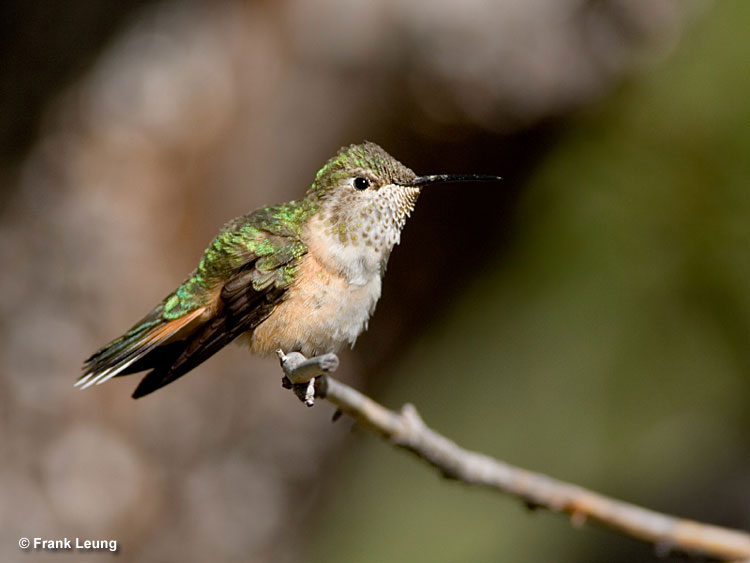
Colorado is an excellent state for birding. Hundreds of species live in the state’s many habitats, hummingbirds included!
Several hummingbird species have occurred in Colorado including some rare ones. Go birding in Colorado and you’ll probably see Broad-tailed Hummingbird, Black-chinned Hummingbird, and a couple other species.
How many hummingbirds live in Colorado? How can you tell them apart?
On this page
Colorado’s Hummingbird Populations
Based on eBird data, there are six hummingbird species in Colorado. Some of them are rarer than others, but let’s take a closer look!
Broad-tailed Hummingbird
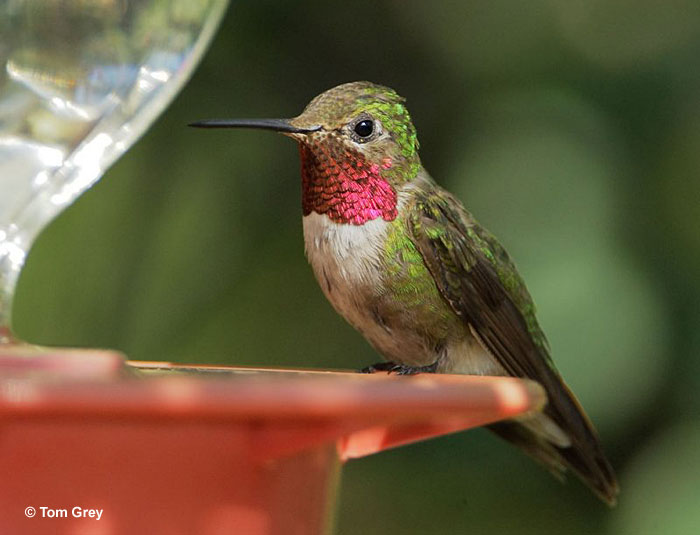
Scientific name: Selasphorus platcercus
Length: 4 inches
Wingspan: 5.25 inches
Broad-tailed Hummingbirds are one of the more common hummingbird species in the Rocky Mountains. If you see a hummingbird while birding in and near the Rockies during the summer months, there’s a good chance it’s a Broad-tailed.
These montane hummingbirds are green above, buffy and green below, have a pale eyering, and a bit of orange on the base of their big, broad tail. Males also have a rose-red throat while females have small spots on their throat.
Like many other hummingbirds, Broad-taileds take nectar from flowering bushes and also visit feeders. They occur higher than most other hummingbirds in North America, even breeding as high as 10,000 feet!
After breeding, Broad-tailed Hummingbirds migrate to montane habitats in Mexico for the winter. No matter the season, this pretty hummingbird is easy to see.
Key identifications:
- Rose-red throat with green and buff underparts.
- Pale eyering.
- A bit of orange on the base of its big, broad tail.
Black-chinned Hummingbird
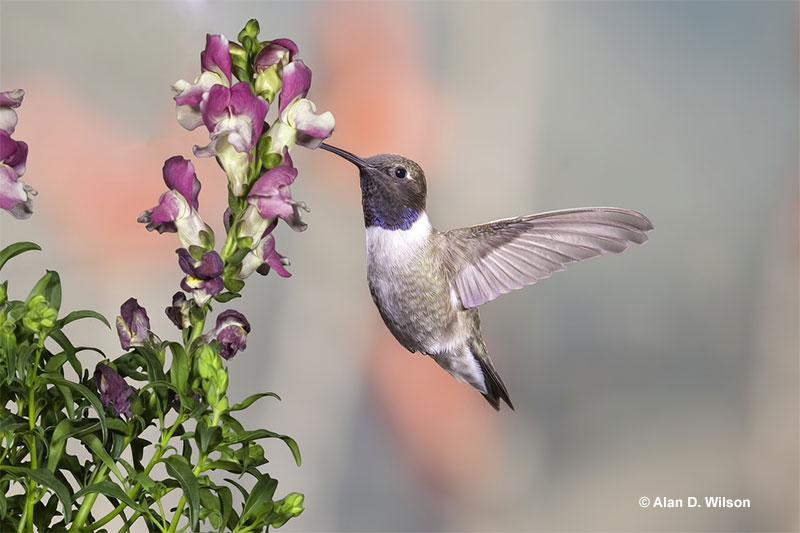
Scientific name: Archilocus alexandri
Length: 3.75 inches
Wingspan: 4.75 inches
Black-chinned Hummingbirds replace the Ruby-throated Hummingbird west of the Rocky Mountains and in parts of central and southern Texas. They are green above and dusky gray below with a white semi-collar and small pale spot behind their eyes.
Males have a beautiful dark purple throat with a black chin, and a black, slightly forked tail. Females have a dusky gray throat, grayish crown, hint of a dark mask, and a slightly forked tail with white tips on the outer tail feathers.
On perched females, the wings nearly reach the end of their tail. These pretty hummingbirds are common at feeders from parts of southern British Columbia to northern Mexico. They also feed from a variety of small tubular flowers and live in riparian zones, brushy habitats, and gardens.
They start migrating back to southern areas in September, but some might stay in Colorado until October!
Key identifications:
- Dark throat with a white semi-collar.
- Grayish belly and black, slightly forked tail.
- On females, look for the grayish crown, long, slightly curved beak, and rounded wing tips that nearly reach the end of their tail.
Rufous Hummingbird
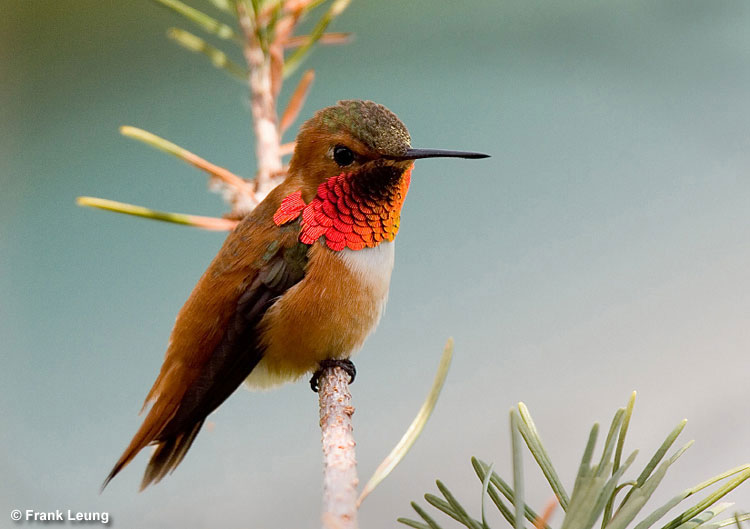
Scientific name: Selasphorus rufus
Length: 3.75 inches
Wingspan: 4.5 inches
Rufous Hummingbirds breed in the coniferous forests of the Pacific Northwest and then fly to central Mexico for the winter. Some even breed as far north as southern Alaska!
Males are pretty, pumpkin orange hummingbirds with white on the upper part of their chest, and an orange-red throat. Some males also have green on their back and crown.
Female Rufous Hummingbirds are green above and white below with pale rufous highlights on their underparts. They also have rufous on the base of their tail, and white tips on their outer tail feathers.
This species often visits feeders, but they can also forage at any number of small tubular flowers. Although they are common birds from the Rocky Mountains west to California, several Rufous Hummingbirds also migrate to feeders in various parts of the eastern USA.
Key identifications:
- Pumpkin orange plumage, especially on the back and head.
- Orange-red throat.
- Rufous on the base of their tail and rump, and broad outer tail feathers.
Calliope Hummingbird
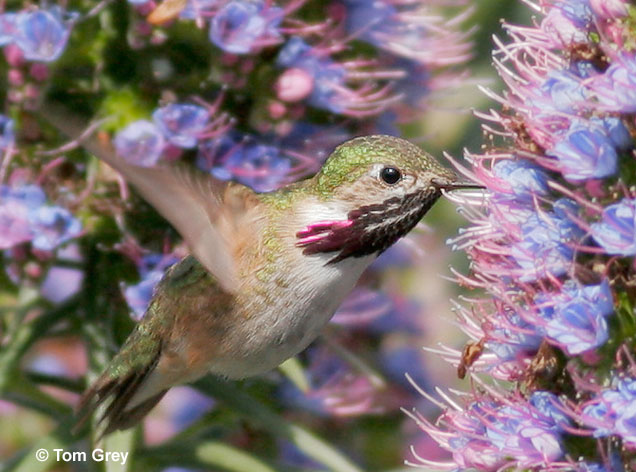
Scientific name: Selasphorus calliope
Length: 3.25 inches
Wingspan: 4.25 inches
Calliope Hummingbirds have the distinction of being the smallest bird in North America. These feathered sprites are green above, pale buffy or pale greenish below, and have a short, squared tail.
They also have shorter, straighter beaks than other hummingbirds and a pale mark behind each eye. Male Calliopes have rose-red streaks on their throats while females have fine, dark streaking.
Calliope Hummingbirds breed in open coniferous woodlands from British Columbia to Utah and parts of central California. During summer and migration to and from Mexico, we can see Calliope Hummingbirds at flowering bushes and feeders.
If you see a tiny hummingbird suddenly sneak into the feeder, it could be a Calliope!
Key identifications:
- Small hummingbird with a squared tail and straight, fairly short beak.
- No rufous in its tail.
- Streaked throat.
Ruby-throated Hummingbird
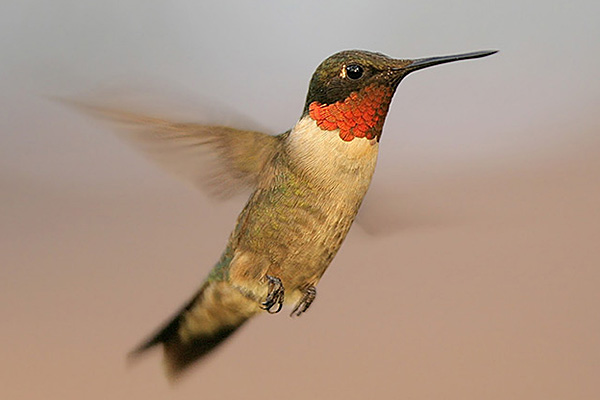
Photograph © Greg Lavaty.
Scientific name: Archilochus colubris
Length: 3.75 inches
Wingspan: 4.5 inches
The Ruby-throated Hummingbird is the common, small hummingbird of eastern North America. Although other, rare species can occasionally occur, at eastern feeders, this species is the de-facto hummingbird.
Males are green above, have some olive on their belly, a white chest and semi-collar, and a tiny white spot behind each eye. True to their name, they also have a beautiful, ruby-red throat. However, as with most hummingbirds, those colors only show in certain lighting.
They also have a dark, slightly forked tail, and a long, needle-like beak. Female Ruby-throated Hummingbirds look quite different from their male counterparts! They are also green above but have a grayish throat, and white tips on their tail.
Ruby-throated Hummingbirds are common in woods, second growth, and gardens near woods. They usually live in eastern states and have the reputation of generally being the most common species, but they are sometimes spotted in western areas as well.
Key identifications:
- Red throat and white semi-collar.
- Dark, slightly forked tail.
- Females have a white spot behind their eyes, a hint of a dusky mask, and the tail of perched birds is longer than their wingtips.
Rivoli’s Hummingbird (rare visitor)

Scientific name: Eugenes fulgens
Length: 5.25 inches
Wingspan: 7.5 inches
Rivoli’s Hummingbirds are one of the most spectacular hummingbirds in the USA. These big, beautiful hummingbirds have long, needle-like beaks, and are as big as a warbler!
Males are green above, black below, have a big, broad tail, and a small white spot behind each eye. In dim lighting, their head can look black but when the light hits it, they show a beautiful amethyst crown and a stunning berylline green throat!
Females aren’t nearly as colorful. They are green above, dusky gray-green below, have a white line going back from their eyes, and a white line from their chin to the lower side of their face.
Rivoli’s Hummingbirds mostly live in Mexico and northern Central America. However, some also breed in the mountains of southeastern Arizona and adjacent New Mexico. In some cases, they might wander as far as Colorado.
Key identifications:
- Big hummingbird with a long beak.
- Males a small white spot behind their eyes and have black underparts.
- Females have a green rump, a white line going back from their eyes, and a white line on the lower part of their face.
FAQ
Are hummingbirds common in Colorado?
Yes, hummingbirds are common in Colorado. Go birding during the summer in Colorado and you should see some hummingbirds.
Do hummingbirds live in mountainous areas?
Yes, hummingbirds live in mountainous areas. The Broad-tailed Hummingbird is a common species in the mountains of Colorado.
Does Colorado have any rarer hummingbird species?
Yes, Colorado has some rare hummingbird species. On occasion, rare species from other places show up in the state.
Do hummingbirds only stay in Colorado for breeding?
Yes, hummingbirds only stay in Colorado for breeding. All hummingbirds in Colorado are migratory.
More in Colorado: Most common birds | Hawks | Owls | Woodpeckers | Ducks | State Bird

